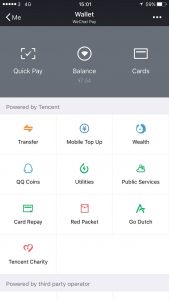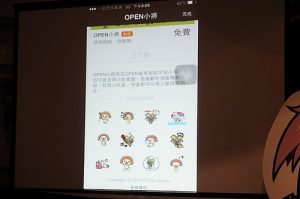
WeChat is the most popular messaging app in China, with more than 1.25 billion monthly active users as of Q2 2021, and from a variety of age groups (Thomala-Lin, 2021). But WeChat is less common if you live outside of China. WeChat is owned by Chinese tech giant: Tencent, one of the largest companies in Asia by market capitalization. (Kharpal, 2019, para.2). The following video provides some information about Wechat.
https://www.youtube.com/watch?v=W1Ghx9_3ZC0
WeChat offers much more than messaging; it has even become an infrastructure for people’s lives, allowing users to do everything from making payments to hailing a ride, from entertainment to work, and even played an important role during COVID-19. Here’s an overview of WeChat’s capabilities and how it operates.
1.Messaging
You can often see one person scanning another person’s phone in China, which is actually the most popular method of exchanging contact information in China right now. Each WeChat user has a unique bar code, called a QR code. Users can scan other users’ QR codes to add friends in Wechat, or they can use their phone number to add and search for people nearby. WeChat also has a social feature called “Moments” where users can upload text, photos or videos to share their lives and their friends can comment or like the post (Kharpal, 2019, para. 7&9). Because of WeChat’s large user base, it is not only a simple social media, but during COVID-19 many companies chose WeChat for online meetings, and WeChat groups became the most convenient way to communicate about work or study in China.

“Scan the QR code and join me on WeChat….” by Anil Chudasama is licensed under CC BY 2.0
2.Official Accounts
In WeChat any business or individual can create an official account which is like a public platform but needs to be certified by WeChat. Companies can post their latest product information on the official account for promotion. Users can also share their opinions about various events. The official account is open to all users and readers can like or comment on the content posted on the official account.
3.Payment methods

WeChat wallet now for louwai by Ged Carroll is licensed under Flickr
You can go out in China without cash or credit cards, a cell phone is enough. That’s because WeChat users can use WeChat Pay almost anywhere in China, whether it’s a roadside stall or a global mall chain. As long as users have a Chinese bank card, it can be tied to WeChat. There are two ways to make payments, the first can be done by scanning the merchant’s receipt Code, and the other merchant can scan your payment code (Kharpal, 2019). Each user has a unique receipt code and payment code for transactions. When shopping online you can also choose WeChat Pay, enter the password set by the user or use fingerprint recognition or face recognition to pay, the process only takes a few seconds. WeChat also provides city services such as cell phone bill recharge, water and electricity bill payment, allowing users to pay their bills online without leaving home.
4.Mini- programs
WeChat is like a collection of all resources and services. Users can use all services in WeChat and make payments directly without downloading the relevant application (Kharpal, 2019). For example, taxi apps, ticket booking apps, etc. These apps become mini-programs within WeChat rather than a standalone app. Such mini-programs provide services directly to users through WeChat and also leverage WeChat’s user base of over 1 billion to expand their reach and achieve profitability. During the COVID-19 the Chinese government made it mandatory for people to show their health codes to enter and exit public places, and the government used WeChat’s large user base to get people to apply and show their health codes through WeChat, which became a necessity for travel.
- How to make a profit
WeChat is a free app to download, but that doesn’t mean WeChat can’t make a profit. WeChat has developed multiple revenue streams, and in 2020, Tencent’s social network revenue was RMB 108.2 billion, accounting for 22% of the company’s total revenue (IQBAL, 2021, para. 8).
Here is a description of the revenue sources
Value-Added Services
Moments, mentioned above, gives users a platform to share their lives by posting text, pictures, videos, articles or music. The stickers (emoji) used to send messages are mostly free, but also available for a fee, with an average price of $0.99 for a set (Kennedy, 2016).

“wechat-5-1” by Sinchen.Lin is licensed under CC BY 2.0
Official Accounts
WeChat users or businesses can create an official account to interact with users or provide services. Official accounts must be verified and cost approximately $45 (Kennedy, 2016). Official accounts can provide services such as reporting news and entertainment channels. Official account operators can receive rewards from readers who approve of their content. WeChat can take some of the rewards.
Games
Mobile games are very popular in China, especially among young people. Tencent, WeChat’s parent company, has been one of the leaders in the Chinese gaming industry with popular games such as PUBG and Arena Of Valor. When users are addicted to a certain game, they choose WeChat to top up in order to get a better experience, which allows them to get better virtual weapons, costumes and skills ((Kennedy, 2016).
Advertising
Advertising is also an important part of WeChat’s revenue. Companies can place ads in WeChat’s “Moments” or official accounts. WeChat charges a fee based on the scope and time of placement, and with over 1 billion users, advertising on WeChat has a much wider reach than TV ads.
Cost of Mini-programs
These small programs in WeChat allow users to use them without downloading an app, and the import of WeChat user traffic has increased the number of clicks on mini-programs, so many apps want to be on WeChat, and WeChat can charge them a fee.
Although WeChat has brought convenience to people’s lives, many problems have arisen as people’s lives have become increasingly inseparable from WeChat.
Monopoly
WeChat has become the most popular social networking app in China, and when people exchange contact information, they exchange not cell phone numbers but WeChat QR codes. WeChat is no longer a simple chatting app, it is closely related to our lives. In July 2013, WeChat experienced a widespread system failure. Users in many places of China reported that they could not send and receive WeChat messages normally, and their “Moments” could not be refreshed. Because people rely on WeChat so much, it can have an impact on work and life when it breaks down.
Invasion of privacy
Nick Srnicek (2017) introduced the concept of ‘platform capitalism’ in his book “Platform Capitalism”. He believes that big platforms extract all kinds of data from users and profile them to further broaden their business scope and become monopolies. When people use WeChat they are often disturbed by people they don’t know, how do these people know the user’s WeChat number? Such questions make users worry about their personal privacy.
Advertising
“Moments” is supposed to be a place to record interesting things around you, and sometimes it’s fun to go to see what your friends are up to, but now Moments is full of ads that can’t even be blocked. These compulsory ads can affect the mood of users and may make them bored.
WeChat has become the most popular app in China, and it is not only a chatting app but also inseparable from people’s lives. But as WeChat becomes more and more important in people’s lives, it can also create problems.
References
“EVERYTHING YOU NEED TO KNOW ABOUT WECHAT.” YouTube, YouTube, 27 Aug. 2017, https://www.youtube.com/watch?v=W1Ghx9_3ZC0.
Iqbal, M. (21 June 2021). “WeChat Revenue and Usage Statistics (2021).” Business of Apps, Retrieved from https://www.businessofapps.com/data/wechat-statistics/.
Kennedy, S. (2018). “Making Money from Messaging- The Wechat Example.” LinkedIn, Retrieved from https://www.linkedin.com/pulse/making-money-from-messaging-wechat-example-sinead-kennedy
Kharpal, A. (4 Feb. 2019). “Everything You Need to Know about WeChat – China’s Billion-User Messaging App.” CNBC, Retrieved from https://www.cnbc.com/2019/02/04/what-is-wechat-china-biggest-messaging-app.html.
Srnicek, N. (2017). “Platform Capitalism” Retrieved from https://mudancatecnologicaedinamicacapitalista.files.wordpress.com/2019/02/platform-capitalism.pdf
Thomala-Lin, L.(25 Aug. 2021). “WeChat: Active Users Worldwide.” Statista, Retrieved from https://www.statista.com/statistics/255778/number-of-active-wechat-messenger-accounts/.